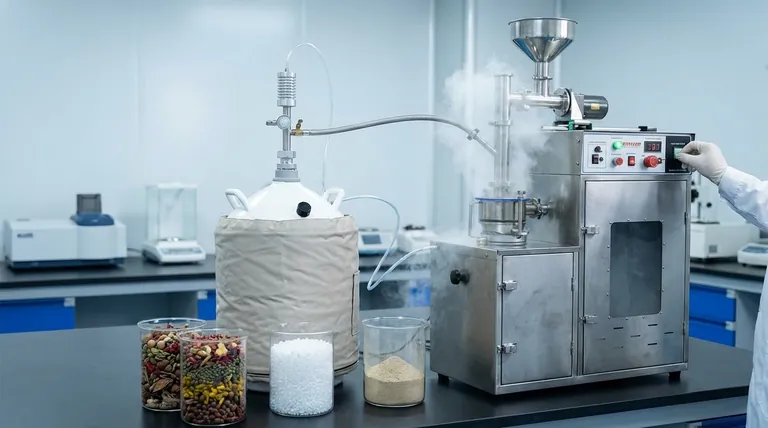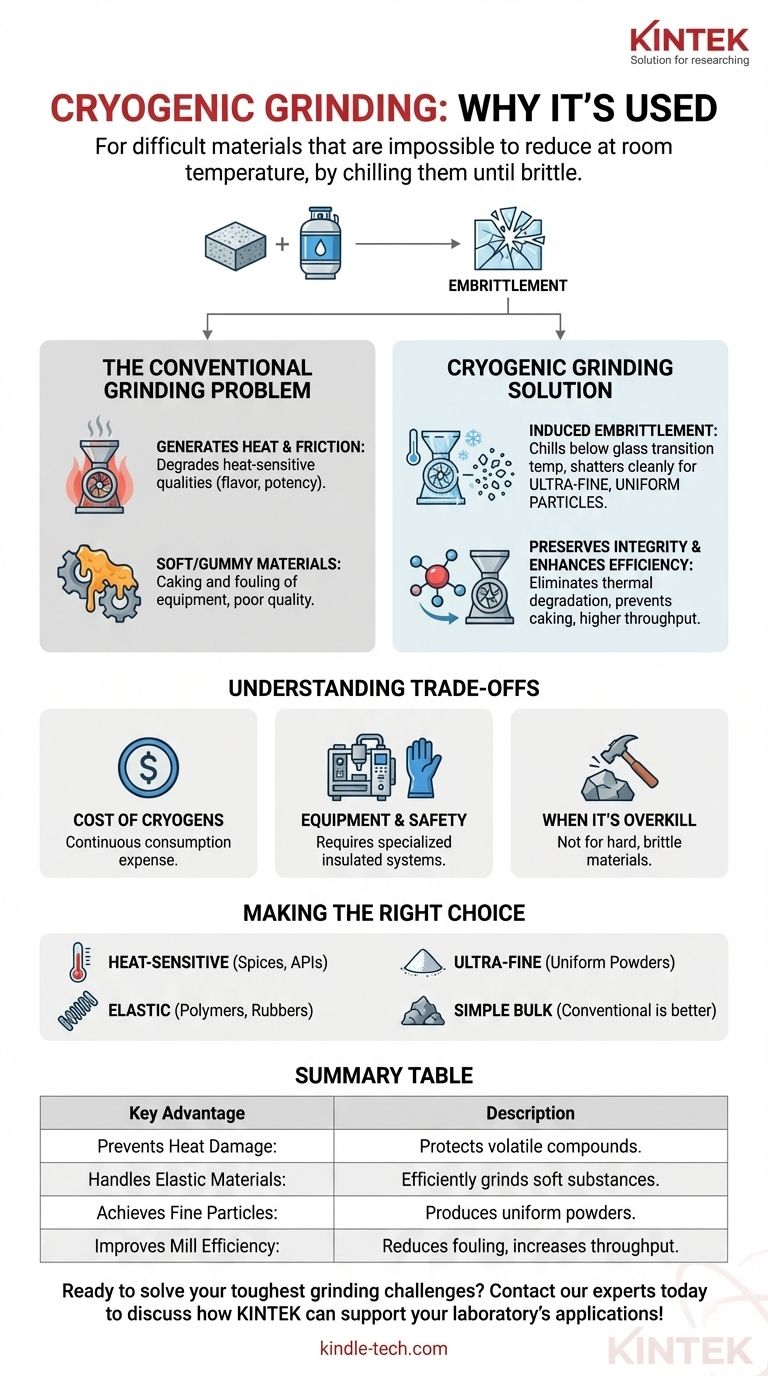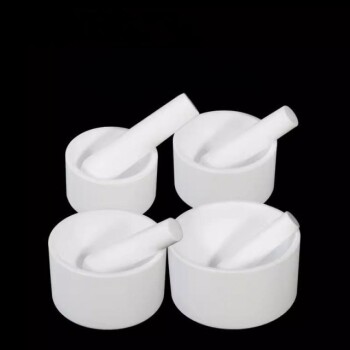À la base, le broyage cryogénique est utilisé pour les matériaux difficiles ou impossibles à réduire en taille à température ambiante. En utilisant un cryogène comme l'azote liquide, le processus refroidit un matériau jusqu'à ce qu'il devienne extrêmement cassant. Cette fragilisation permet un éclatement efficace en particules fines et uniformes, évitant des problèmes tels que la fusion, le caractère collant ou la dégradation des composants thermosensibles.
L'objectif principal du broyage cryogénique n'est pas simplement de refroidir un matériau, mais de modifier temporairement ses propriétés physiques, le faisant passer de ductile et résistant à dur et cassant. Cette transformation permet de surmonter les défaillances courantes du broyage conventionnel, telles que les dommages thermiques, l'encrassement des outils et la taille de particules incohérente.

Le problème fondamental du broyage conventionnel
Les méthodes de broyage standard reposent sur une force mécanique – impact, cisaillement ou compression – pour décomposer les matériaux. Bien qu'efficace pour de nombreuses substances, ce processus génère un frottement et une chaleur importants.
Génération de chaleur et ses conséquences
L'énergie intense du broyage est en grande partie convertie en chaleur. Pour les matériaux thermosensibles comme les épices, les produits pharmaceutiques ou certains polymères, cela peut dégrader ou détruire les qualités mêmes que vous souhaitez préserver, telles que la saveur, l'arôme ou la puissance chimique.
Le défi des matériaux mous ou gommeux
De nombreux matériaux, en particulier les plastiques, les élastomères et les cires, ne se broient pas bien à température ambiante. Au lieu de se briser, ils deviennent mous, collants ou élastiques sous la contrainte du broyeur. Cela entraîne un encrassement et un colmatage de l'équipement, une réduction du débit et une mauvaise qualité des particules.
Comment le broyage cryogénique résout le problème
Le broyage cryogénique aborde directement les limites de la chaleur et de la ductilité en introduisant un froid extrême dans le processus, modifiant fondamentalement le comportement du matériau.
Le principe de la fragilisation
Le refroidissement d'un matériau en dessous de sa température de transition vitreuse lui fait perdre ses propriétés ductiles et le rend cassant et vitreux. Lorsque la force de broyage est appliquée, le matériau fragilisé se brise proprement et instantanément. C'est la clé pour obtenir des particules ultra-fines et très uniformes.
Préservation de l'intégrité du produit
Comme l'ensemble du système est inondé d'un cryogène inerte comme l'azote liquide, la chaleur est immédiatement absorbée. Cela élimine la dégradation thermique, protégeant la qualité des composants thermolabiles. Cela empêche également l'oxydation en déplaçant l'oxygène, préservant davantage l'intégrité du produit final.
Amélioration de l'efficacité du broyeur
En empêchant les matériaux de devenir collants, le broyage cryogénique élimine l'agglomération du produit à l'intérieur du broyeur. Il en résulte des taux de production significativement plus élevés, une consommation d'énergie plus faible par unité de produit et une usure réduite des composants de broyage. Le processus est plus rapide et nécessite moins de temps d'arrêt pour le nettoyage.
Comprendre les compromis et les considérations
Bien que puissant, le broyage cryogénique est un processus spécialisé avec des exigences spécifiques. Ce n'est pas une solution universelle pour toutes les tâches de broyage.
Le coût des cryogènes
Le coût opérationnel principal est la consommation continue d'azote liquide ou d'un autre cryogène. Cette dépense doit être justifiée par la valeur ajoutée, telle qu'une qualité de produit améliorée ou la capacité de traiter un matériau autrement impossible.
Complexité de l'équipement et de la sécurité
Les systèmes cryogéniques nécessitent des machines isolées, un équipement de manipulation spécialisé et des protocoles de sécurité stricts pour la gestion des substances extrêmement froides. L'investissement initial et la complexité opérationnelle sont plus élevés que pour les configurations de broyage conventionnelles.
Quand c'est excessif
Pour les matériaux durs et cassants qui se broient facilement à température ambiante (par exemple, les minéraux, les sels ou les céramiques), le broyage cryogénique n'offre aucun avantage significatif et n'ajouterait que des coûts et une complexité inutiles.
Faire le bon choix pour votre application
Le choix de la bonne méthode de broyage dépend entièrement des propriétés de votre matériau et de vos objectifs de produit final.
- Si votre objectif principal est de préserver les qualités thermosensibles : Le broyage cryogénique est essentiel pour protéger les composés volatils dans les épices, les aliments et les ingrédients pharmaceutiques actifs (IPA).
- Si votre objectif principal est de traiter des matériaux mous ou élastiques : Le broyage cryogénique est la méthode supérieure pour les polymères, les caoutchoucs, les cires et les adhésifs qui fondraient ou encrasseraient l'équipement autrement.
- Si votre objectif principal est d'obtenir des poudres ultra-fines et uniformes : Le processus de fragilisation permet un niveau de contrôle et de cohérence de la taille des particules souvent inatteignable avec les méthodes conventionnelles.
- Si votre objectif principal est la réduction en vrac rentable de matériaux simples : Le broyage conventionnel reste le choix le plus économique et le plus simple pour les matériaux qui ne sont pas thermosensibles ou ductiles.
En modifiant fondamentalement l'état physique d'un matériau dans le but de réduire sa taille, le broyage cryogénique ouvre des capacités de traitement autrement inaccessibles.
Tableau récapitulatif :
| Avantage clé | Description |
|---|---|
| Prévient les dommages thermiques | Protège les composés volatils dans les épices, les produits pharmaceutiques et les polymères. |
| Traite les matériaux élastiques | Broie efficacement les substances molles et collantes comme les plastiques et les caoutchoucs. |
| Obtient des particules fines | Produit des poudres ultra-fines et uniformes par fragilisation du matériau. |
| Améliore l'efficacité du broyeur | Réduit l'encrassement de l'équipement, augmente le débit et diminue la consommation d'énergie. |
Prêt à relever vos défis de broyage les plus ardus ? Si vous travaillez avec des épices, des produits pharmaceutiques, des polymères ou d'autres matériaux difficiles à broyer et thermosensibles, les solutions de broyage cryogénique de KINTEK peuvent préserver la qualité de votre produit et améliorer l'efficacité de votre processus. Notre expertise en équipement de laboratoire vous assure d'obtenir le bon système pour vos besoins. Contactez nos experts dès aujourd'hui pour discuter de la façon dont nous pouvons soutenir les applications de broyage de votre laboratoire !
Guide Visuel

Produits associés
- Broyeur cryogénique à azote liquide Cryomill avec vis d'alimentation
- Utilisation du broyeur cryogénique à azote liquide pour la pulvérisation de matières premières plastiques et de matériaux sensibles à la chaleur
- Pulvérisateur ultrafin vibrant refroidi par eau à basse température avec écran tactile
- Mouture de laboratoire avec pot et billes de broyage en alumine et zircone
- Broyeur hybride de laboratoire pour tissus
Les gens demandent aussi
- Qu'est-ce que le processus de broyage cryogénique ? Obtenez une qualité et une efficacité supérieures pour les matériaux sensibles
- Quel est l'objectif d'un pulvérisateur ? Libérez le potentiel des matériaux grâce au broyage fin
- Qu'est-ce que le broyage en laboratoire ? La clé d'une préparation d'échantillons précise
- Qu'est-ce que le broyage cryogénique des aliments ? Le guide ultime pour préserver la saveur et l'arôme
- Quel outil pourrait être utilisé pour pulvériser un objet ? Faites correspondre l'outil à la dureté et à la fragilité de votre matériau



















